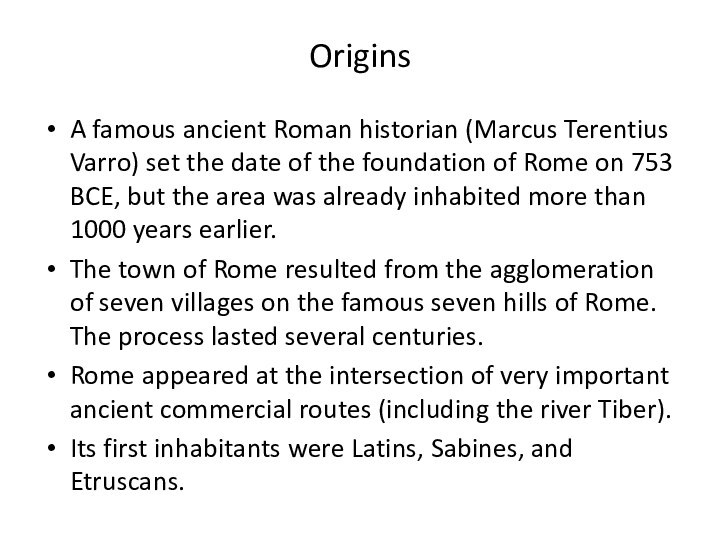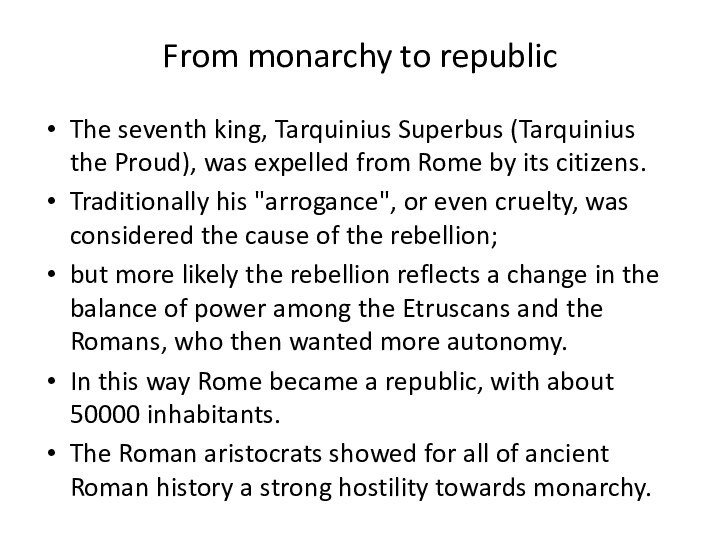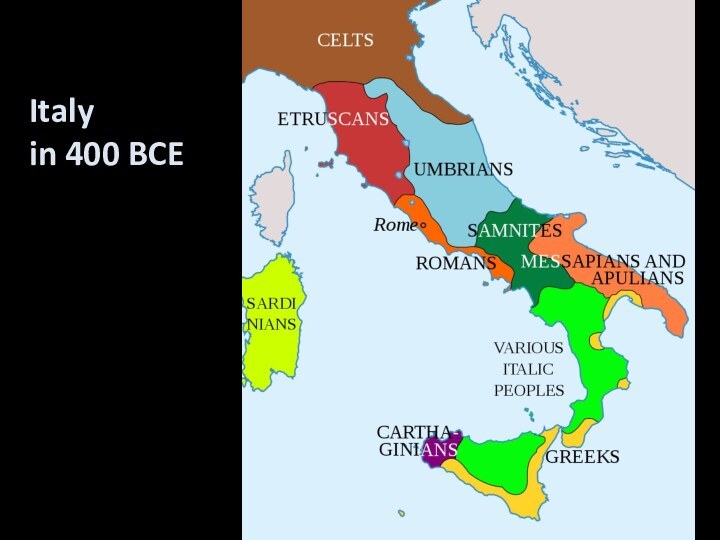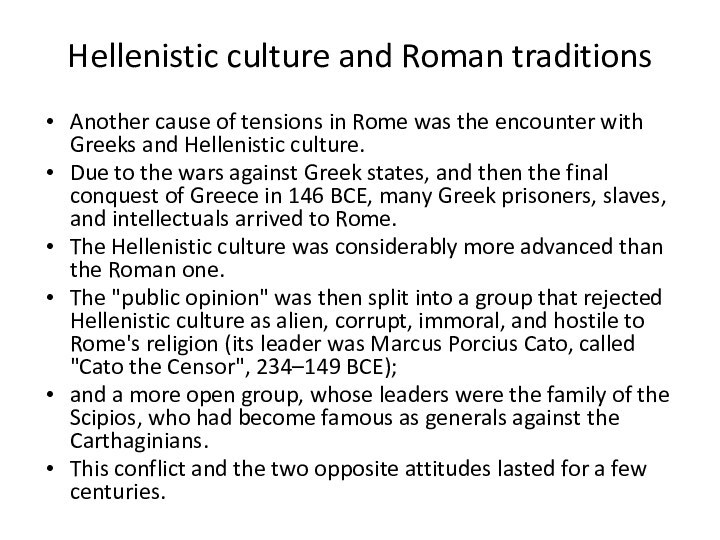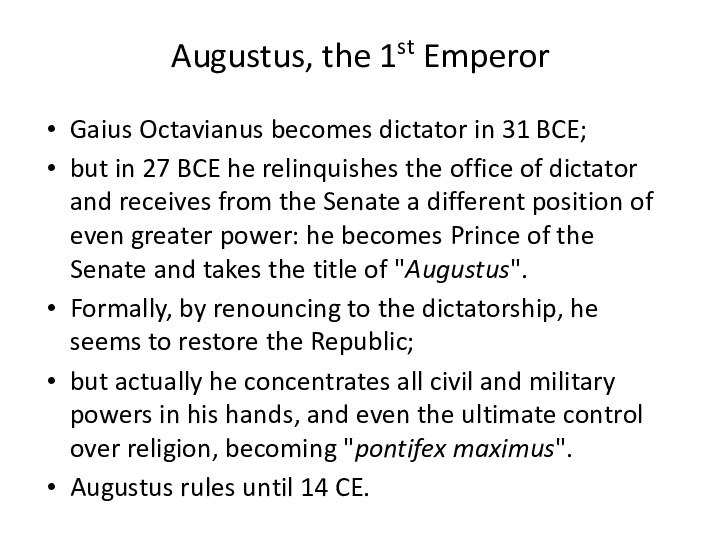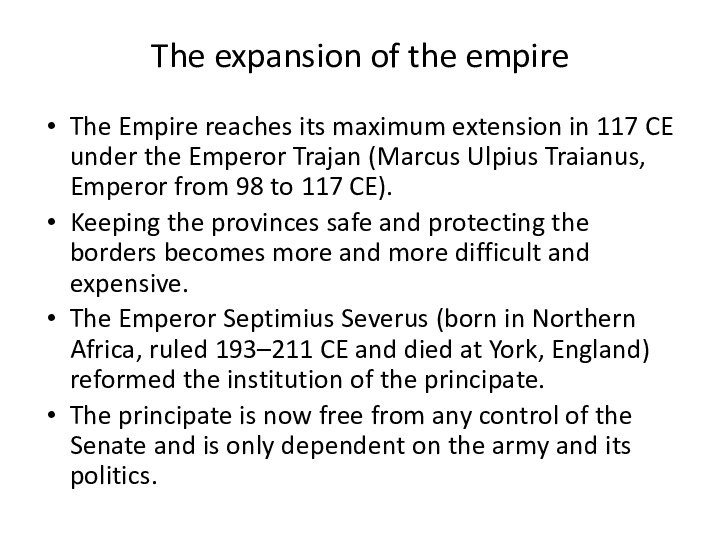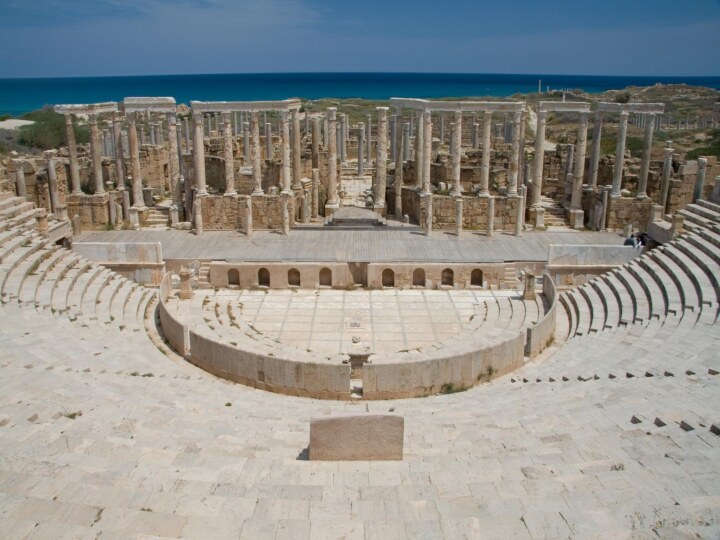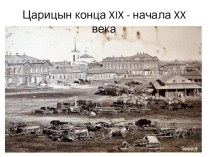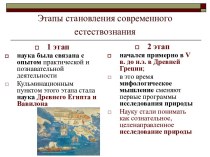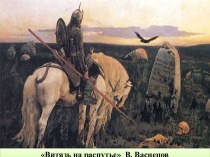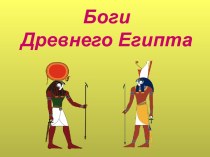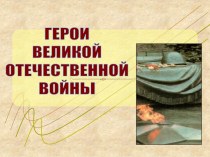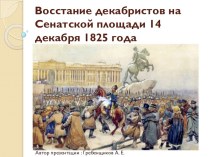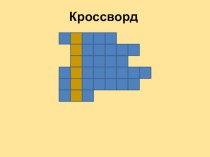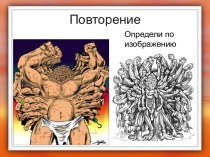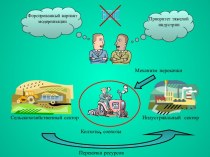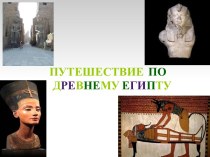Слайд 2
Origins
A famous ancient Roman historian (Marcus Terentius Varro)
set the date of the foundation of Rome on
753 BCE, but the area was already inhabited more than 1000 years earlier.
The town of Rome resulted from the agglomeration of seven villages on the famous seven hills of Rome. The process lasted several centuries.
Rome appeared at the intersection of very important ancient commercial routes (including the river Tiber).
Its first inhabitants were Latins, Sabines, and Etruscans.
Слайд 3
The seven kings
The first four kings of Rome
described by the ancient historians are usually considered as
legend.
The last three kings (reigning from 616 to 509 BCE) are considered as historical (real) persons.
They were Etruscans and gave a significant impulse to the development of Rome, especially by improving the organization of the army and of the state organization.
The sixth king (Servius Tullius) also organized the first census (registration of citizens and property mostly for military and fiscal purposes).
Слайд 4
From monarchy to republic
The seventh king, Tarquinius Superbus
(Tarquinius the Proud), was expelled from Rome by its
citizens.
Traditionally his "arrogance", or even cruelty, was considered the cause of the rebellion;
but more likely the rebellion reflects a change in the balance of power among the Etruscans and the Romans, who then wanted more autonomy.
In this way Rome became a republic, with about 50000 inhabitants.
The Roman aristocrats showed for all of ancient Roman history a strong hostility towards monarchy.
Слайд 5
Expansion in Italy
For two centuries and a half
Rome fights against various peoples in the Italian peninsula:
Etruscans, Latins, Aequi, Volsci, Sabines, Samnites, Gauls, Bruttii and the Greeks that inhabited Southern Italy.
On 270 BCE Rome eventually incorporates also the Greek poleis of Southern Italy and remains the main power in the central and southern parts of the Italian peninsula.
Слайд 7
Social conflict
The 4th century BCE is also marked
by significant internal struggles between the aristocrats and the
common people (the plebs).
The common people had remained until the middle of the 4th c. BCE excluded by the civil and political rights enjoyed by the aristocracy, and several serious protests ensued.
Eventually, in the middle of the 4th c., the plebs obtains the right to elect its own representatives (the tribunes of the plebs), and the right to perform any public office.
Слайд 8
Master of the Mediterranean
After many wars against the
Gauls in the North, and other Italic and Greek
peoples in the Center and South of the peninsula, and against Carthaginians and Macedonians in the Mediterranean Sea area, Rome remains as the main Mediterranean power.
In 146 BCE Rome celebrates two fundamental victories: the complete destruction of Carthage (main rival in the Mediterranean) and the complete conquest of Greece.
Слайд 9
Carthaginian area of influence prior to the First
Punic War (264 BCE)
Слайд 10
Slavery and social crisis
Rome is then the absolute
master of the Mediterranean Sea area and extends its
rule to Iberia (modern Spain), Northern Africa, Greece, Asia Minor (western peninsula of Asia that now constitutes most of modern Turkey.)
The constant wars brought to Rome very big numbers of slaves, who were employed in agriculture, thus causing the deep crisis and the dramatic impoverishment of the free agriculturists.
Many of these, poor and unemployed, started to crowd into Rome creating serious political tensions.
Слайд 11
Hellenistic culture and Roman traditions
Another cause of tensions
in Rome was the encounter with Greeks and Hellenistic
culture.
Due to the wars against Greek states, and then the final conquest of Greece in 146 BCE, many Greek prisoners, slaves, and intellectuals arrived to Rome.
The Hellenistic culture was considerably more advanced than the Roman one.
The "public opinion" was then split into a group that rejected Hellenistic culture as alien, corrupt, immoral, and hostile to Rome's religion (its leader was Marcus Porcius Cato, called "Cato the Censor", 234–149 BCE);
and a more open group, whose leaders were the family of the Scipios, who had become famous as generals against the Carthaginians.
This conflict and the two opposite attitudes lasted for a few centuries.
Слайд 12
The turbulent 1st century BCE
In the 1st century
BCE the Republic enters a crisis, especially due to
the manipulation of the social tensions existing in Rome between common people and aristocrats by a few ambitious politicians (like Marius (157–86 BCE) against Sulla (138–78 BCE), Julius Cesar (100–44 BCE) against Pompey (106–48 BCE)).
There was in these times also an attempt of invasion by Germanic peoples; great rebellions of slaves in Southern Italy and in Sicily, and especially a great war against an alliance of many Italic peoples, the so called "Social War" or "War of the Allies" (91-88 BCE).
Rome won the war but had to concede the Roman citizenship to all peoples of the Italian peninsula who hadn't raised arms against Rome (90 BCE).
Слайд 13
Marius’ reform of the Army
An important transformation happened
in the army with the reforms made by its
head Marius in 107 BCE.
Before, the army had been composed of citizens, mostly agriculturalists and peasants, who opposed long military campaigns. After the war, they returned to their homes and fields.
Marius, instead, transformed the army into a professional, permanent army composed of volunteers.
The volunteers were mainly poor men who served for 20 years and were paid with money and booty from the campaigns, including land from the conquered territories.
So the soldiers' loyalty shifted soon from the state and the people to the army itself, and especially its heads.
Слайд 14
Crisis and end of the Republic
It's likely that
the geographic extension of the Roman Empire itself placed
an excessive burden on the institutions of the Roman Republic, that appeared slow in taking decisions.
In the 1st c. BCE Roman politics is dominated by charismatic figures of dictators, like Marius, Sulla, Julius Caesar (from 46 to 44 BCE, when he was assassinated).
These dictators refused to become and to be called kings, but their power was almost absolute.
They didn't want to completely overturn the existing constitution, but used the exceptional powers legally granted to them to rule.
Indeed the Roman constitution had the office of "dictator" for emergency situations; but emergency was quickly becoming the norm!
Слайд 15
Augustus, the 1st Emperor
Gaius Octavianus becomes dictator in
31 BCE;
but in 27 BCE he relinquishes the
office of dictator and receives from the Senate a different position of even greater power: he becomes Prince of the Senate and takes the title of "Augustus".
Formally, by renouncing to the dictatorship, he seems to restore the Republic;
but actually he concentrates all civil and military powers in his hands, and even the ultimate control over religion, becoming "pontifex maximus".
Augustus rules until 14 CE.
Слайд 17
The expansion of the empire
The Empire reaches its
maximum extension in 117 CE under the Emperor Trajan
(Marcus Ulpius Traianus, Emperor from 98 to 117 CE).
Keeping the provinces safe and protecting the borders becomes more and more difficult and expensive.
The Emperor Septimius Severus (born in Northern Africa, ruled 193–211 CE and died at York, England) reformed the institution of the principate.
The principate is now free from any control of the Senate and is only dependent on the army and its politics.
Слайд 20
From the Principate to the Dominate
After the Dynasty
of the Severi (193-235) there is the so called
Period of military anarchy (235-285):
the legions elect the emperors, who often rule for very short periods and must often fight away for Rome to defend the Empire.
In this time there is the expansion of Christianity, that the Roman authorities partially tolerate and partially combat.
After the military anarchy, the next Emperors establish the new system called Dominate (285-476).
The Dominate is a clear break with the Roman tradition.
Probably influenced by Eastern kingdoms (Egypt, Persia), the Roman Emperors assume a more and more autocratic and despotic character.
Also against the Roman tradition, a process of divinization of the Emperors starts.
Слайд 21
The division of the Empire
With the Emperor Diocletian
(from Dalmatia, reigns 284-305) the subdivision of the Roman
Empire into a Western and an Eastern part begins.
Rome stops being the imperial capital. Other towns are chosen in more peripheral places to help defend the frontiers.
Constantine I builds Constantinople on the site of the Greek Byzantium to create a "new Rome".
Constantine is the 1st Christian Emperor.
With Theodosius I (379-395) Christianity becomes the Empire's official religion.
Слайд 23
End of the Roman Empire
In the 4th century,
the Empire is very weakened and cannot prevent the
immigration of Germanic peoples especially in the Italian peninsula.
In the 5th century, the Eastern and the Western Empire are definitively divided.
The Western Empire is almost reduced to the sole Italy.
The Empire and the designation of the Emperors are now controlled by Germanic generals of the Roman army.
In 476 the barbarian soldier Flavius Odoacer deposes the last Emperor, Romulus Augustus, and sends the imperial insignias to the Eastern Emperor Zeno.
Odoacer becomes the first King of Italy.
This is the end of the Roman Empire.

